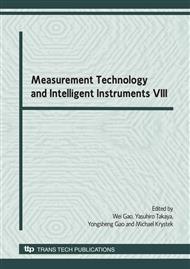p.175
p.179
p.183
p.187
p.191
p.195
p.199
p.203
p.207
Measurement Method for Micro-Cavity Based on Improved MAP Algorithm
Abstract:
In order to improve the measurement precision, an improved MAP algorithm is proposed to increase the edge aiming precision in this paper. The algorithm breaks the limitation of degenerated model, takes two actual factors into account, one is the distortion caused by motion, which solved by Huber-Markov random filed in the improved MAP algorithm, and the other is curvature of field, which solved by Delaunay triangle method. The algorithm can restore the high-frequency information of image, keep the edge character of image, and increase the aiming precision of the edge during the measurement. The experiments show that the uncertainty of location for the image captured in the measurement can be improved three folds, and the repeatability uncertain is less then 0.8µm when the diameter of φ0.2mm hole is measured using the proposed MAP algorithm and length-measuring interferometer together.
Info:
Periodical:
Pages:
191-194
Citation:
Online since:
June 2008
Authors:
Price:
Сopyright:
© 2008 Trans Tech Publications Ltd. All Rights Reserved
Share:
Citation:


